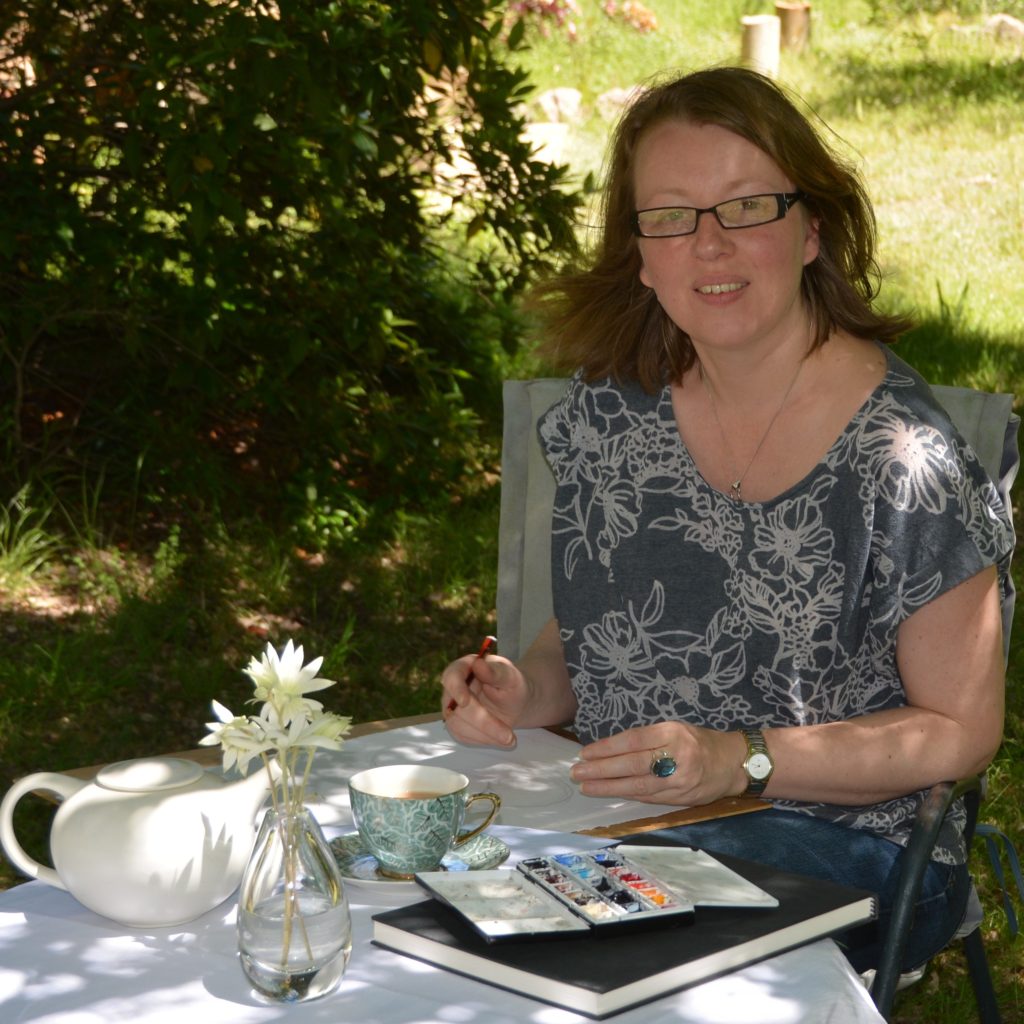Denise Faulkner Painter, NSW, Australia
Denise Faulkner, Mudgee, NSW, Australia
Nostalgia and Nature are captured together.
Zoneone Arts brings Denise Faulkner to you…
Mudgee is truly country Australia; how has this remoteness affected your art?
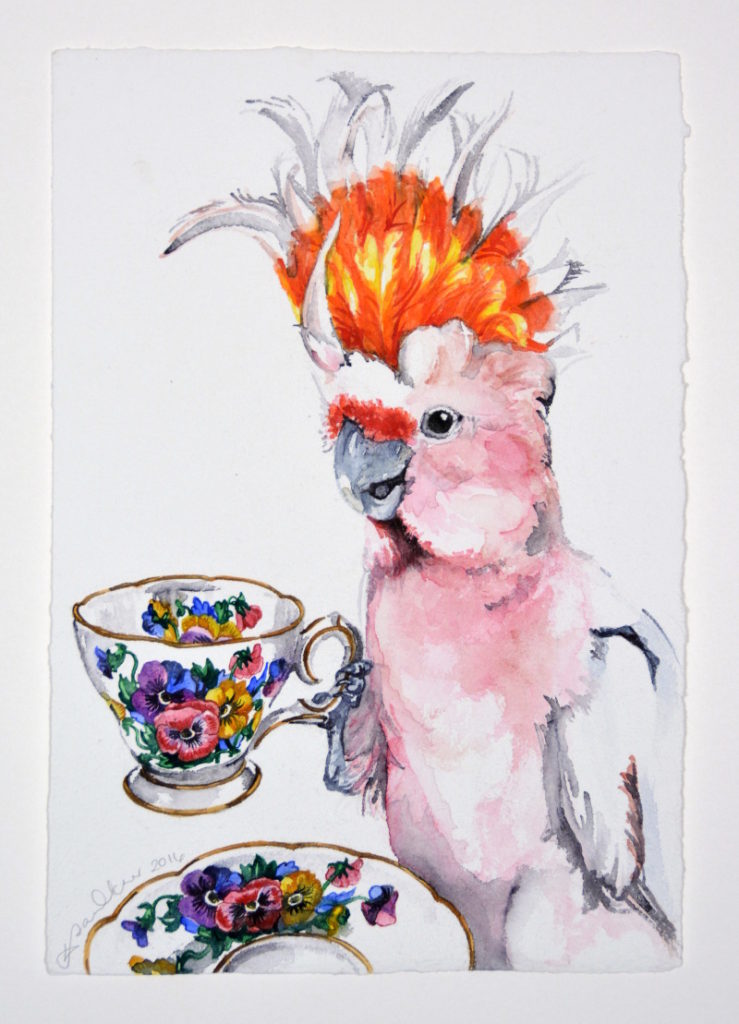
Beatrice, 2017, 45 x 31 cms
Coming from the city it is near impossible to be an artist, in Sydney especially. The rents are so astronomical, you really must work full time just to stay afloat, and then there is very little time for anything creative. I did very little painting from when I left the National Art School over twenty years ago to moving to Mudgee. I just didn’t have the time or the energy. When we moved to our bush block outside of Mudgee, I moved here without a driver’s licence, not needing one in Sydney, so was completely isolated. My partner was working, often travelling back to Sydney or Melbourne, so I would have weeks by myself just pottering around our property watching all the amazing birds which would visit our garden. I had never seen so many different sizes, colours and shapes.
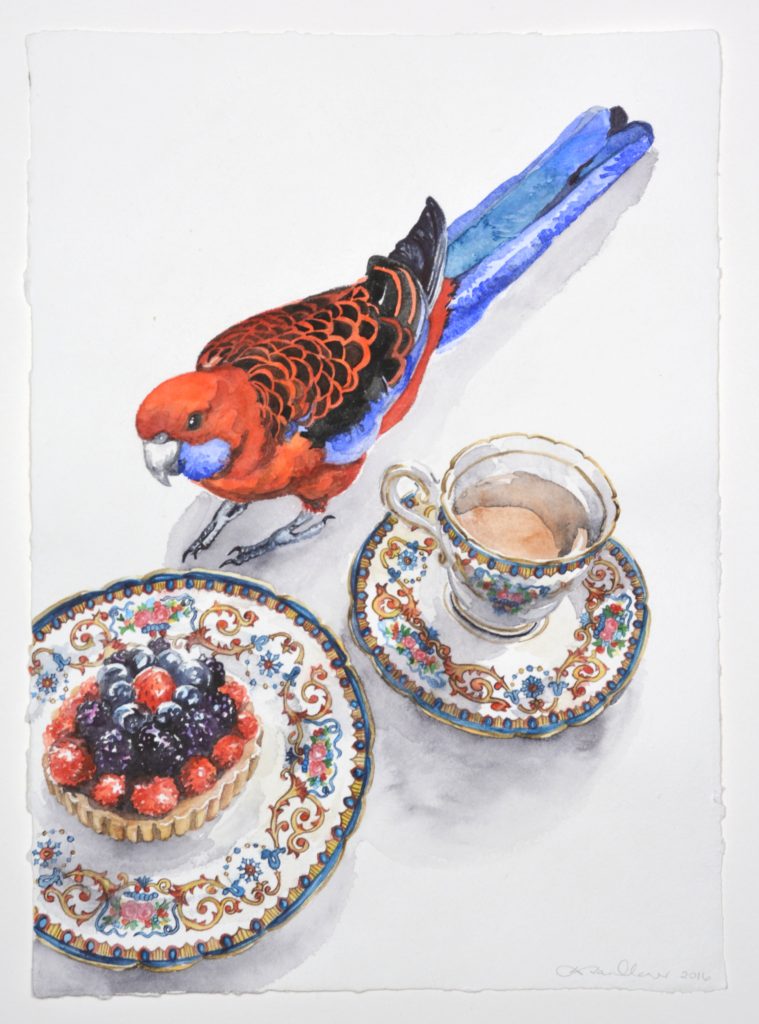
Knave of Hearts, 2016, 62x46cms
Each with their own personalities so I set about trying to photograph and identify them. From there it seemed natural to try and paint them. Suddenly I was inspired, I had time to create and with our remoteness, not even being in Mudgee itself, I had no real distractions, except by my models as they flitted around the yard and splashed in our bird baths.
How did your years of working at the Art Gallery of NSW helped to train your own artistic eye?
I had a wonderful job at the art gallery of New South Wales being the book buyer for the Gallery Shop. I had access to what was happening in the art world both locally and internationally through what was being published, as well as being surrounded daily by the most amazing art in the gallery itself. Unfortunately, the downside was that being surrounded by so much amazing talent (and some not so amazing talent, if I am honest) made question my own skills. The things I wanted to paint and the way I wanted to paint them were not edgy nor controversial, my style was quite conservative, I found it quite hard to see where I could fit in the contemporary art market as I saw it. It did, however, give me a very clear idea of what I did and didn’t like, and I found that the artists who worked in and with nature were the ones which resonated with me the most. At that, time I had no idea that I too would be heading down that path. I was also always drawn to the few decorative arts pieces in the Art Gallery of NSW’s collection, wishing that we had had the extensive collection that the NGV had.
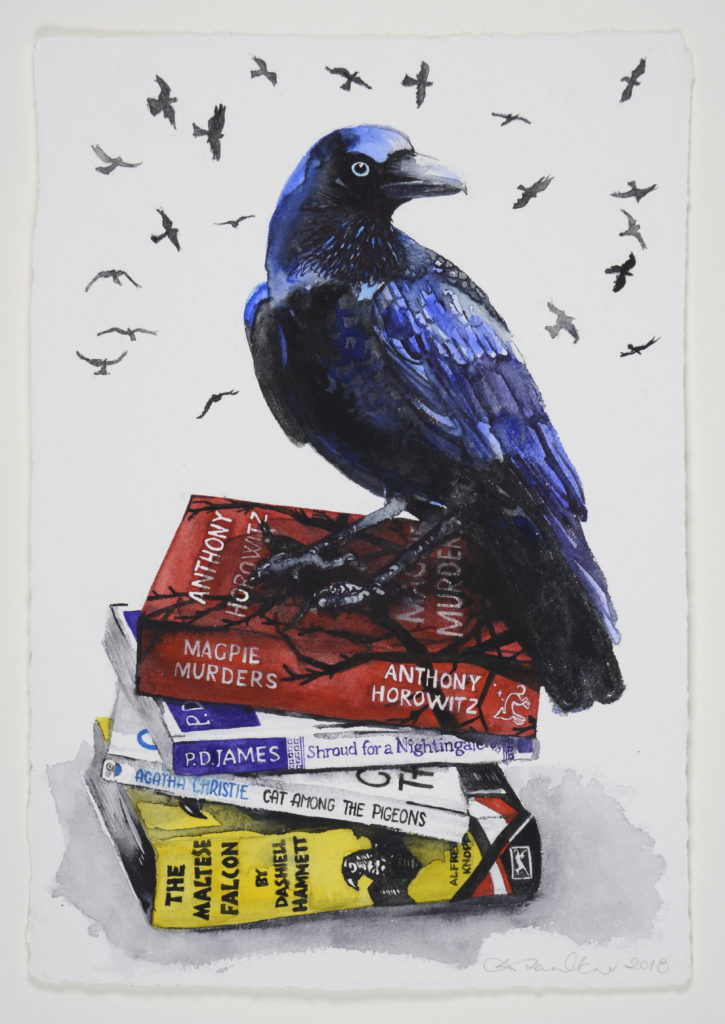
Murder of Crows, 2018, 45x31cms
I love your combination of birds and fine china. How did this come about?
Even though we are in the middle of nowhere we had a poor little scrawny stray cat turn up and mew pathetically at our front door. As we already had a cat, we gave him some cat crunchies in the only small bowl we had, a little china one decorated with Japanese blossom. The resident mother magpie saw this and came over to finish what was left in the bowl after the stray had left. I took lots of photos and set about to paint her as the “Magpie Thief” complete with pretty bowl.
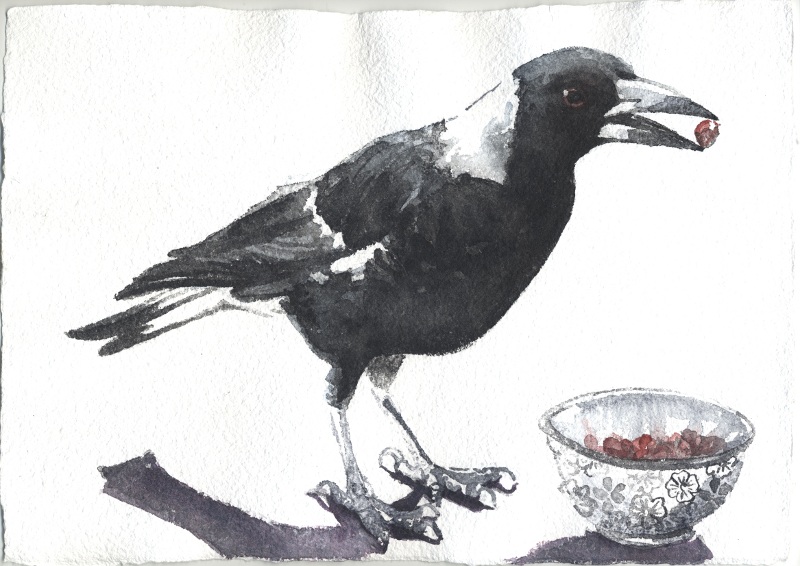
Magpie Thief, 2015, 21.5×30.5cms
She was the one who started the whole series. From there it was not too much of a stretch to see our birds stealing sugar cubes and cakes, bathing in Victorian wash bowls, pretending to be a spray of flowers in a beautiful vase.
I have always been drawn to beautifully decorated objects and patterns, it is for me a kind of nostalgia, in a world where everything feels homogenised and mass produced, I find it very meditative to focus on the exquisite detail of the chosen pieces and appreciate all the work which has gone into them.
Are all your birds’ Australian natives? Or do you occasionally allow an immigrant in?
Most of the birds are ones which visit us in our yard, or are local to the area, as I use my own photographs wherever possible. They may even be birds from weekends away or on holidays. I spent a week in Noosa just before my first solo exhibition, so took hundreds of photos most of them of the birds prevalent in that area, bush turkeys and pelicans, which came in handy when getting ready for the show at Bundaberg Regional Gallery a few years later. Using my own photographs means that I have had a chance to watch the subject, often getting an idea of their personality and a connection with them, something you don’t get from a photograph on its own.
I have however had the pleasure of painting a commission for a lovely lady in the US last year who wanted a cardinal on a teacup to give to her friend.
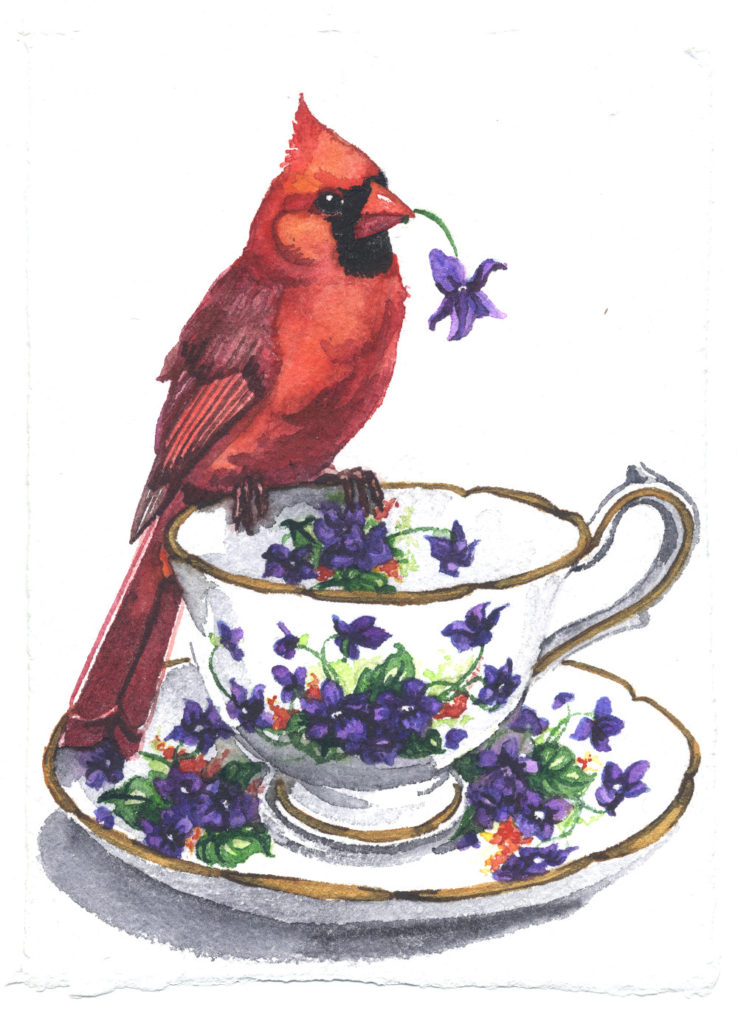
Violet Cardinal, 2017, 22x15cms
It was such a treat being able to paint a different bird to the ones I usually paint. Even though I have never seen a cardinal, I knew they were related to our finches, so when I came to be painting the bird, I just imagined our little finches, dressed up in a red costume just so I could capture a connection and give the bird I saw in the photos some personality.
Sure, peacocks and flamingos are gorgeous birds and would be a treat to paint, I have no real connection with them, so would find it difficult to convey their personality, something I like to think comes across in my paintings.
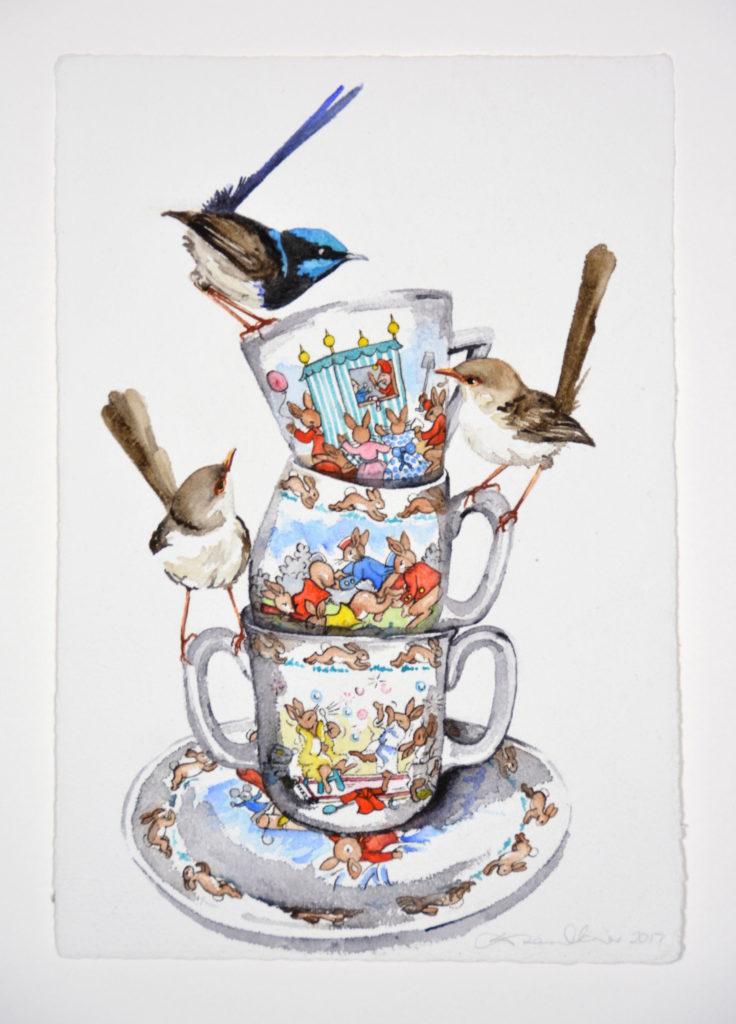
Tea-Tottering Bunnykins, 2017, 45x31cms
I do, however, have plans to paint some sparrows, they are birds from my childhood in Sydney, which have been forced out of most Sydney suburbs by the larger, more aggressive birds, so when I moved to Mudgee and saw them still in the town I was delighted. I just haven’t quite worked out what mischief they will be up to yet.
Where do you source your china?
I source my china from everywhere. I have quite a personal collection growing, and no space to put it, but I also have friends send me photographs, I sneak into old wares stores and museums and take photos, there is also a truly fantastic cafe in Mudgee, Artisan on Lewis, where I had my very first solo exhibition. They have an amazing collection of old crockery and are more than happy for me to take reference photos. I also use books and the internet.
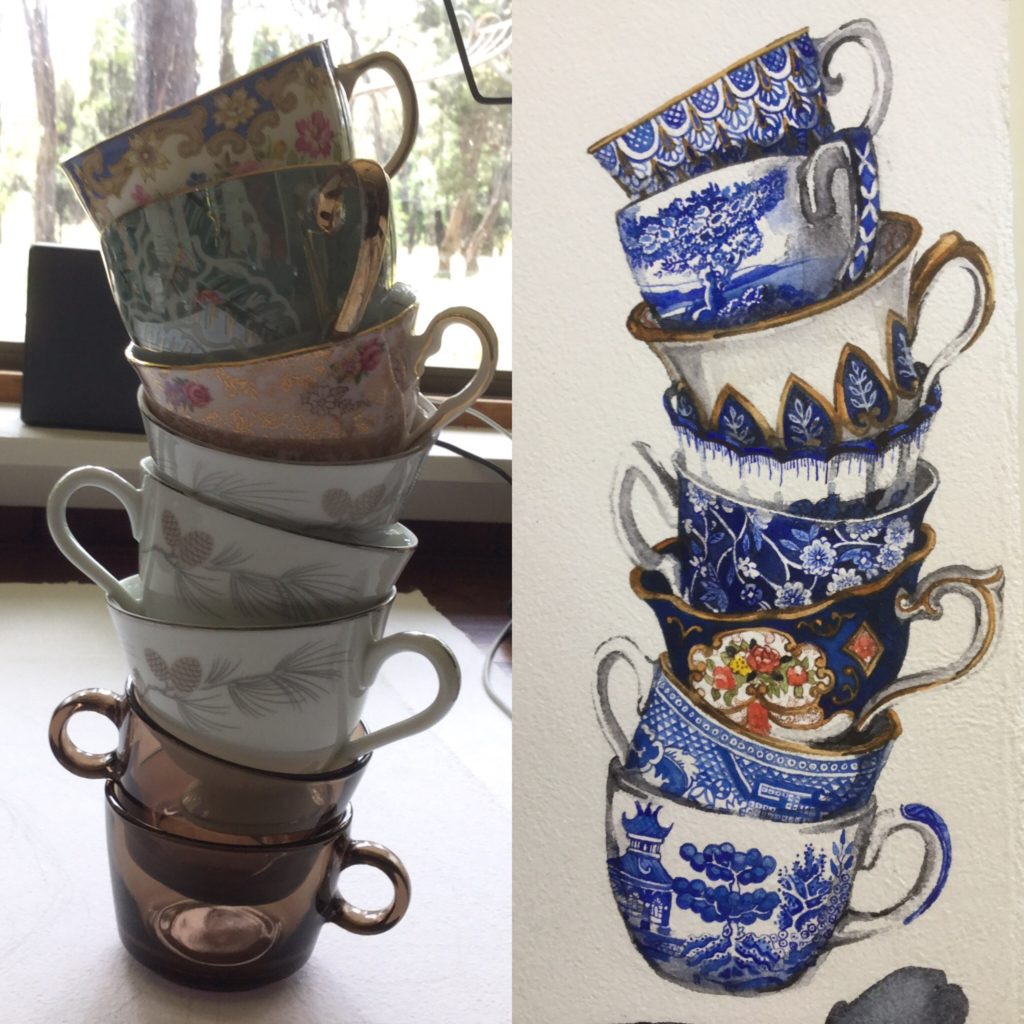
Making a Tower Bower
I will set up my still life tableau using my own tea sets, pots etc, to get the layout and shadows right, then transpose the designs taken from books, photos and the internet into my scene based on their aesthetics. I think of it as a painted collage, of sorts.
Have you considered using local ceramic or glass artists work in a similar way?
Being so close to Gulgong which is known for its kaolin clay there are so many amazing local ceramicists, but it is the colour and detail I love in the vintage porcelain pieces I paint, which does not seem to be in vogue amongst the local artisans. Don’t get me wrong, I love the rustic utilitarian style which is common here, and we have bought many local ceramics pieces, but it is the intricate detail which I find very meditative to paint. I also like that many of the pieces I choose are universally recognisable.
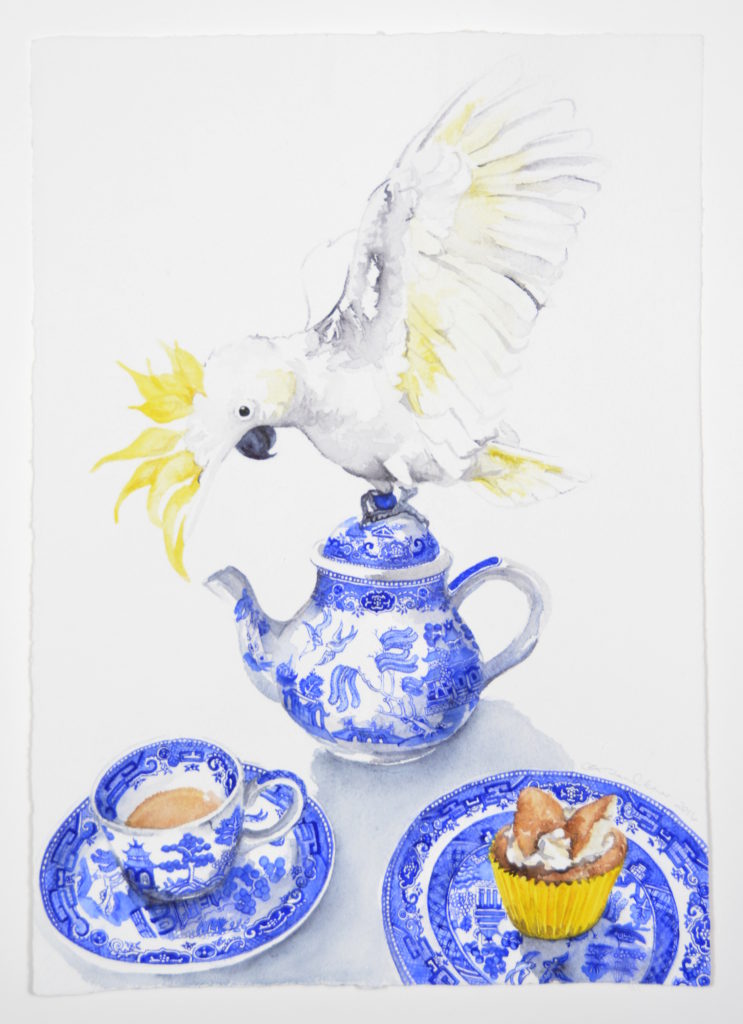
Mad Hatter, 2016, 62x46cms
My grandmother had a willow pattern dinner set, I now have a willow pattern tea set. Many of the comments I get on social media from people all around the world are about recognising a particular, tea set or piece, “My grandmother had that tea set” is a quite common comment. I want everyone to feel that connection, the same nostalgia I get from these pieces. They may not know the birds, especially if they are overseas, but they may recognise the designs.
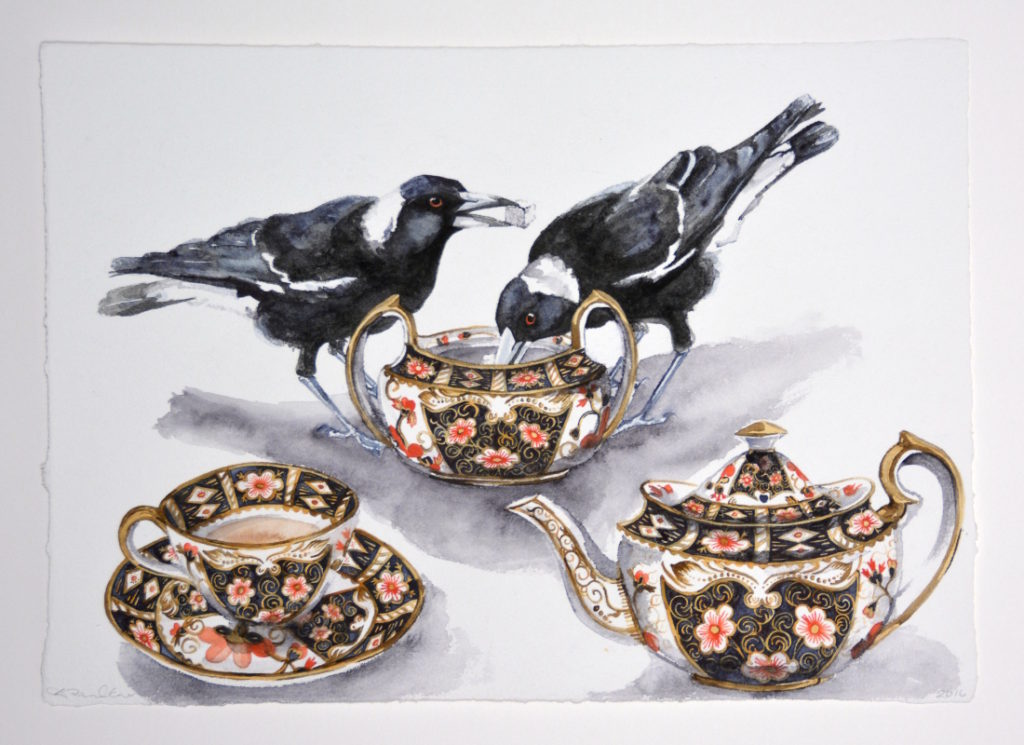
One Lump or Two, 2017, 46x62cms
What bird book do you use to identify your feathered friends?
I have a much loved and much thumbed “Simpson and Day Field Guide to the Birds of Australia”.
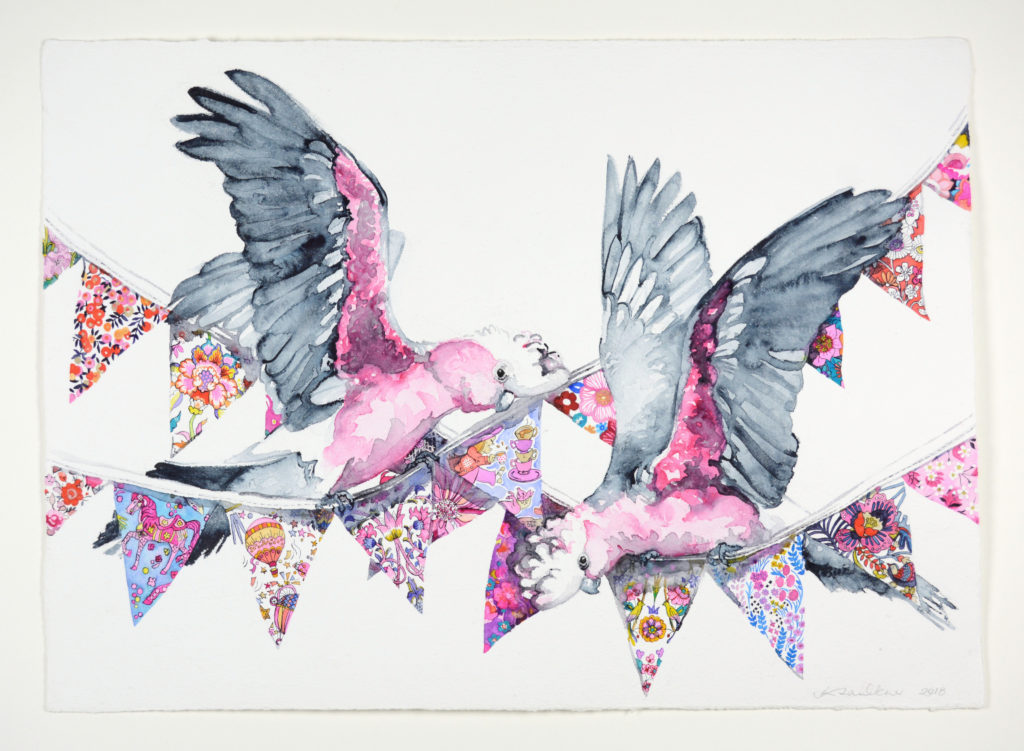
Such Galahs, 2018, 57x80cms
I do have many other books on Australian birds, but the “Simpson and Day” is our ‘go to’ bird book. That combined with a National Parks checklist to the birds found at Munghorn Gap, a nature reserve very close to where we live is how we try to identify most of our garden visitors. As a bird accidentally strays into our yard, often to use one of our many bird baths, I will attempt to photograph it, pull out the bird bible (as we refer to it) identify our feathered friend and then tick it off the bird list. It is a very exciting day when we can tick a new bird off the list. We are currently up to 74 birds in our own back yard alone, that is not including the ones we have seen in the region… and of course those we have been unable to positively identify. One day I am going to produce a book on how to identify birds from underneath or from behind, because really, that is how most of us get to see them, or as a fuzzy blob which flits past at great speed.
On you prints you use your bird logo. discuss this.
That bird logo is of my favourite of all the mini birds, the spotted pardalote.
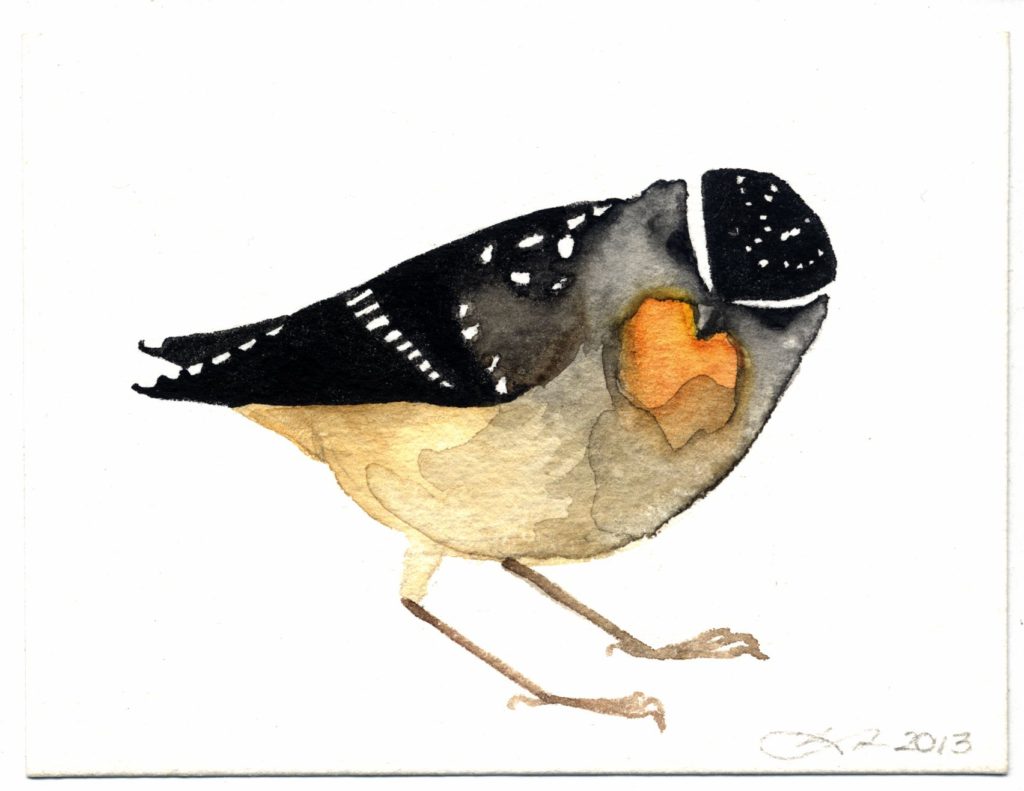
Pardalote, 2013, 10x15cms
I was so excited the very first day I saw one and I managed to get an ok enough photo to paint his portrait from. Normally these tiny little birds spend their days in the tops of trees eating lerp, a type of sticky sweet crystallised honeydew often found on eucalyptus leaves. They only come down to nest, building burrows in retaining walls and riverbanks. I suspect that this little fellow had come down to see what his nesting options were. He was so sweet and unusual, and because I too have a sweet tooth, he became my little mascot, I even have a gorgeous hand painted porcelain one by local artist Margot Stephens dangling over my desk for inspiration.
I would use my painting of him on my business cards, on the back of my greeting card range in fact anything which warranted any sort of branding. When I decided to start producing fine art prints, I knew he had to be involved somehow. I reduced him to his basic elements and had him made into an embossing die. That way I can sign, number and emboss each fine art print as a way of authentication.
Discuss the tea themed group show that was held at the Bundaberg Regional Art Gallery and you part in it?
I had the absolute honour to be included in a group exhibition “You Me and a Cup of Tea” at Bundaberg Regional Gallery in early 2017 which celebrated all things tea. Curated by Zoe Blandford and including such wonderful artists as Beverley Budgeon, Susan Gourley and Kim Schoenberger, it also included ten regional artists who were asked to reinterpret a familiar Australian biscuit. I had fortuitously just been to the region the year before for a holiday, so had plenty of photos of their local birds, so when I was asked to be involved, I was able to include birds from that region in my paintings. I was then told that the gallery had quite a collection of vintage tea cups, so a couple of the paintings had tea cups from their collection in them. “Beatrice” and “Neville” featuring a major Mitchell cockatoo and a sulphur crested cockatoo, both birds found in the region featured tea cups from their collection and are now part of the permanent collection at Bundaberg Regional Gallery.
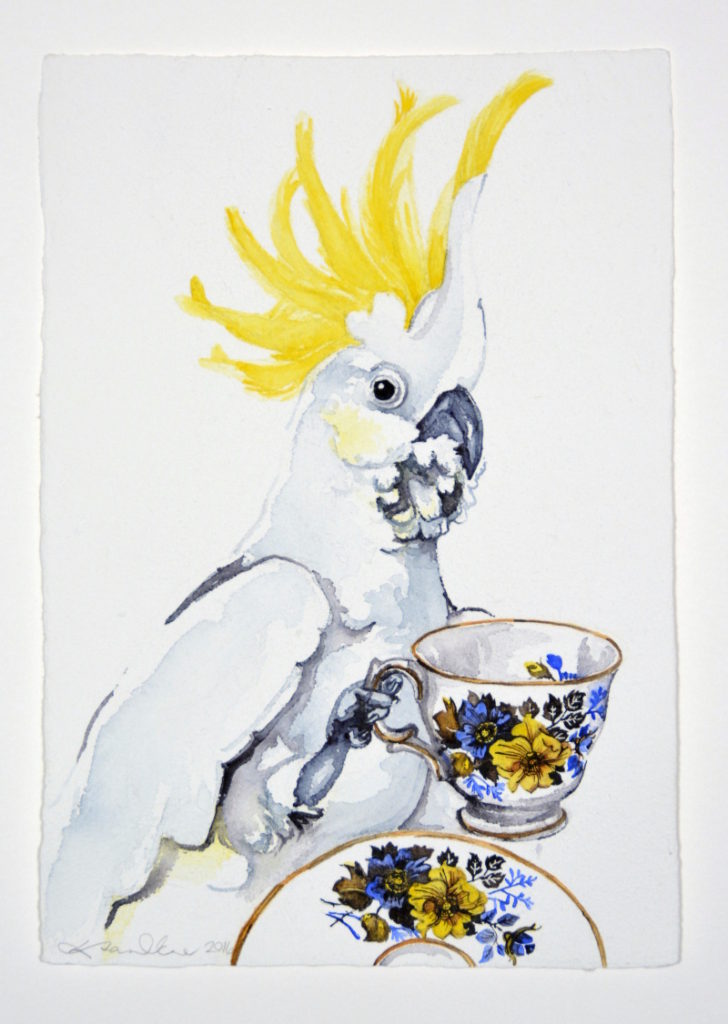
Neville, 2017, 45x31cms
Discuss how important Australian, Regional Art Galleries are to the local population and local artists.
Having a regional gallery gives a cultural identity to a town. Admittedly a lot of it is based on who the Director is, and what direction they take the gallery in, and what sort of exhibitions and public programs they engage in. But to me I feel it is very important to have a space in which you can just go and stop and look and feel and absorb. Something we often neglect to do in this busy day and age. Whether you like the work shown or not, often doesn’t matter. It is impossible to not be inspired, whether through wonder, or a desire to do better and often becomes a breeding ground of creative ideas.
I am still amazed that the Mudgee region does not currently have its own regional art gallery. Now, we have to travel to Dubbo, Bathurst or Orange. I know I was spoilt working in the Art Gallery of NSW for thirteen years. I could stroll around in my lunchtime and absorb the surrounds, the peace, the tranquillity which comes with looking at art. Also, the access to new art, new ideas, and out here the stories of Australia are very important. I spend a lot of time in the local history museums, which we have a wealth of, it gives me a chance to appreciate the local ingenuity, but it is the easy access to art I miss.
It is also often a space to showcase the local talent, and there are a lot of talented artists in Mudgee. You can afford to be an artist here as life is cheaper, but you can still get a good coffee. A must if you want to be an artist, in my opinion.
I moved into a town without a bookshop or a regional art gallery, two places I never thought I could live without. Living without a bookshop is probably healthy for my bank account, living without a regional gallery is quite difficult. It gives a place a cultural identity, stimulating thought and creativity. It shows both the visitors and residents of the region that there is more to life than just existing.
Explain your ‘Alice in Wonderland’ series. Was this a tribute to the book reaching the milestone of 100 years?
That was not intentional. I have always loved Alice in Wonderland, from childhood. It was an important book for me as a child. It was only when I moved out here that I realised that it would have been far easier for Alice to fall down a wombat hole, rather than a rabbit hole.
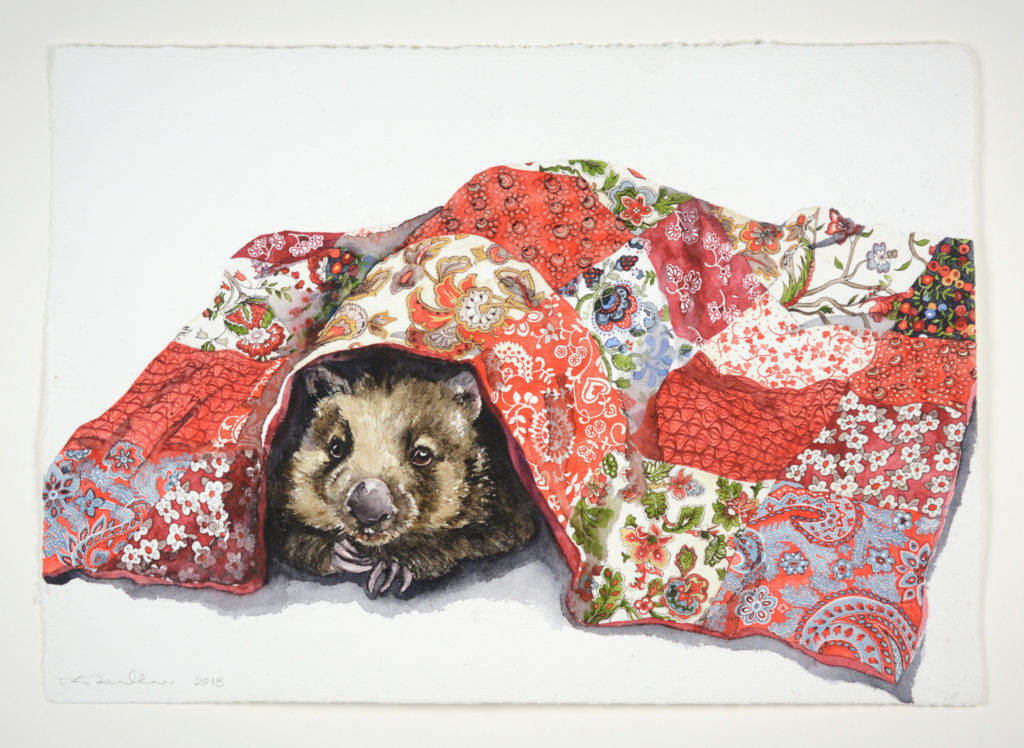
Wisdom of Wombat, 2018, 46x62cms
We certainly have a curious array of animals, just as fantastical as anything in Alice in Wonderland… When I was coming up with the initial theme for my first solo show, “10 Impossible Things” at Michael Reid Murrurundi in 2016it seemed appropriate to incorporate this in some way, especially as the then Director set me an ‘impossible’ task, to produce ten works in six weeks, as they had a hole in their exhibition schedule. It was an opportunity I could not resist. In Alice she could imagine as many as six things before breakfast, well I could imagine ten things in a rather short timeframe. Plus, I always wanted to do a kind of ‘Alice in Down-Underland’… I had already painted a crimson rosella eyeing off a berry tart, so it seemed obvious that he would be my Knave of Hearts, getting ready to steal that tart and the rest was easy. Our regular pair of galahs became Tweedledee and Tweedledum because they were always together and always up to mischief, and of course the Mad Hatter had to be a sulphur crested cockatoo with his crest as his hat, and the maniacal gleam in his eye to do the rest.
I followed that exhibition up with another Down-Underland influenced show “Curiouser and Curiouser” in 2017.
Explain how your greeting cards have changed your artistic life.
I would say they were the main contributing factor to where I am now, and I would recommend it as a promotional tool to anyone who’s work would translate well into a greeting card.
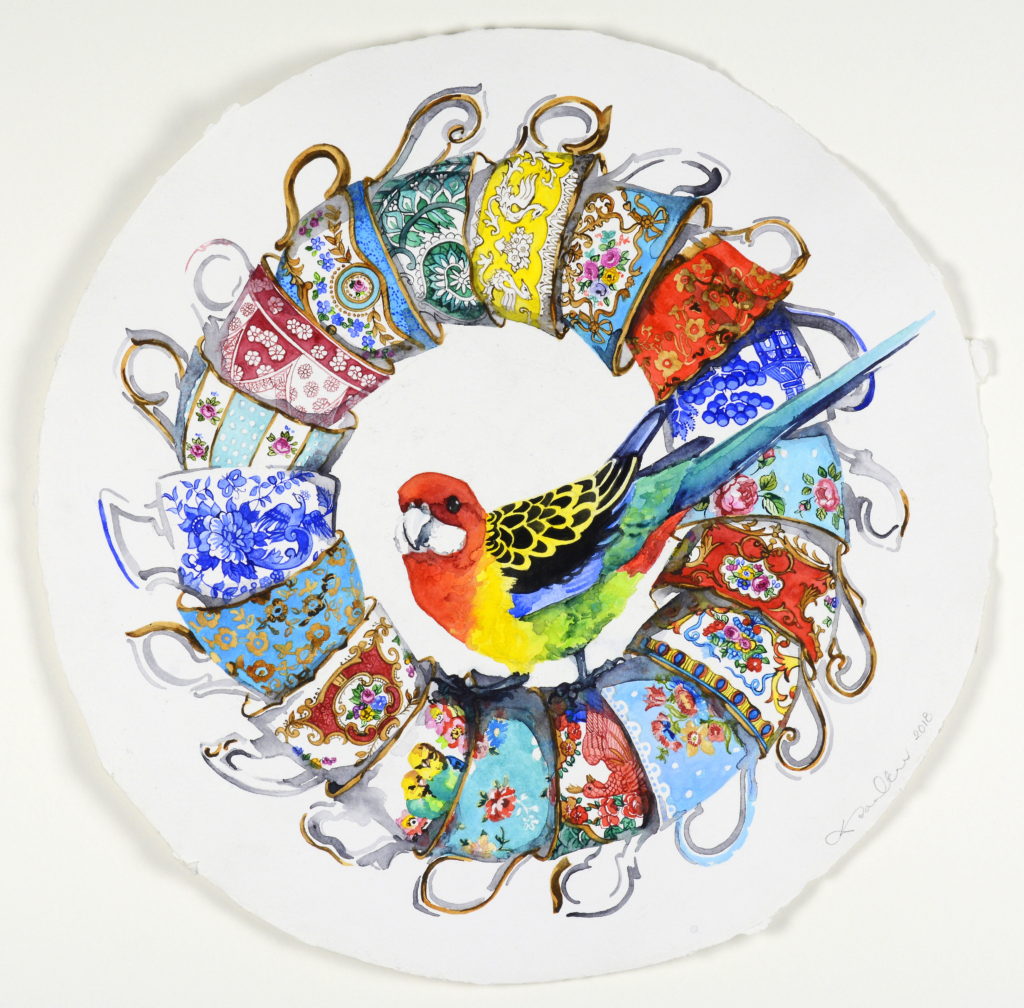
Ring A Rosie, 2018, 50 cms round.
If you are going to do it, you must do it well. If you can, print locally, that way, not only are you supporting a small local business such as yourself, but you can get test prints done to ensure the colours are as close as you can get them. Make sure you brand them to yourselves, if you have a website, put your website of the back or any sort of contact details. To me it is a type of business card, which people pay money for, and then they give them away, effectively distributing your ‘business card’ far and wide. Not everyone can afford an original artwork, but most people can afford a greeting card.
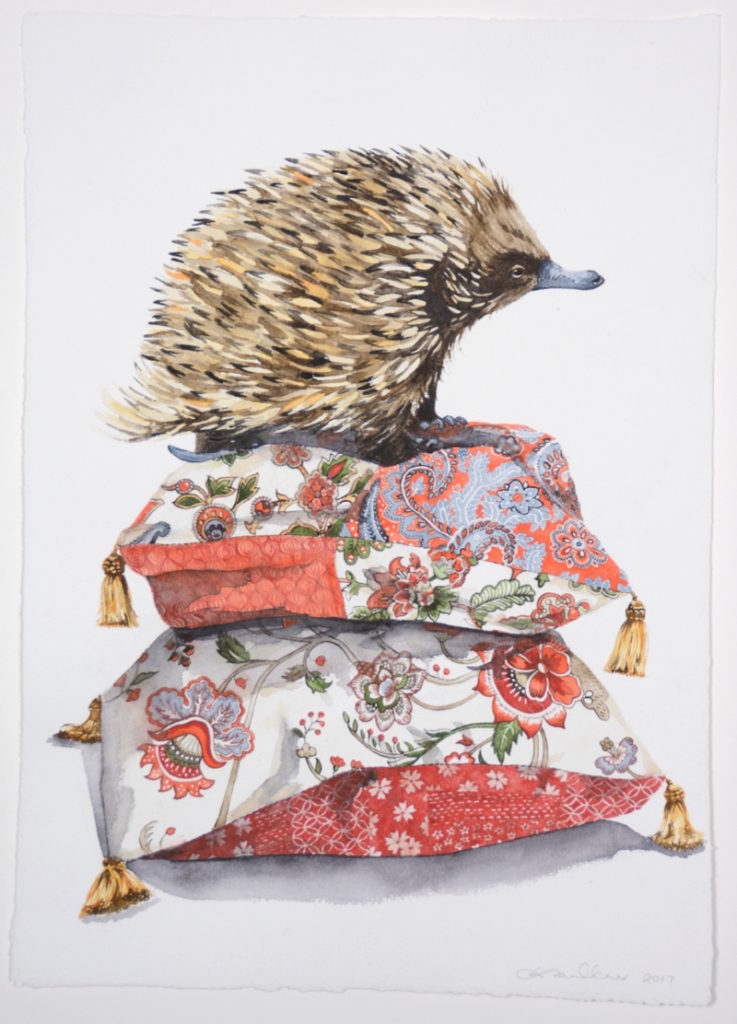
Pin Cushion, 2017, 62x46cms
It was by sending a promotional pack of my greeting cards to Michael Reid’s Murrurundi gallery that got me on their radar. They put some of my original works in their stockroom which ultimately sold, so they offered me an exhibition. And all it took was a pack of my greeting cards.
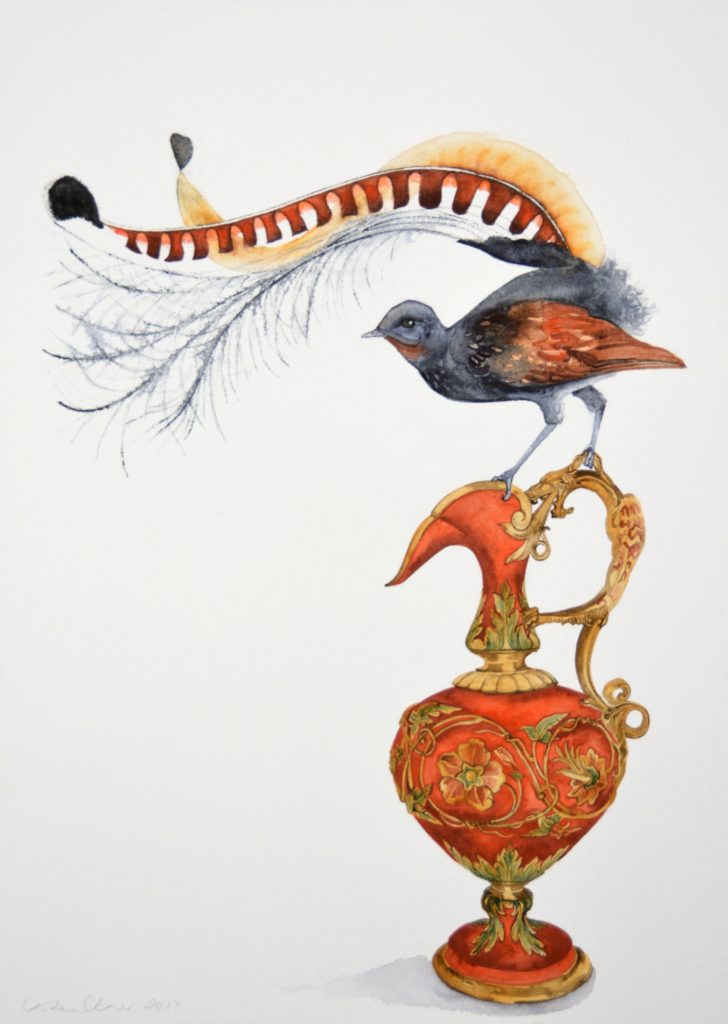
Pretty as a Pitcher, 2017, 80 x 75cm
Contact details:
Denise Faulkner
Email: denise@denisefaulkner.com
Website: https://denisefaulkner.art
Denise Faulkner, Mudgee, NSW, Australia
Interview by Deborah Blakeley, November 2018
Think a colleague or friend could benefit from this interview?
Knowledge is one of the biggest assets in any business. So why not forward this on to your friends and colleagues so they too can start taking advantage of the insightful information the artist has given?
Other artists you may be interested in:


